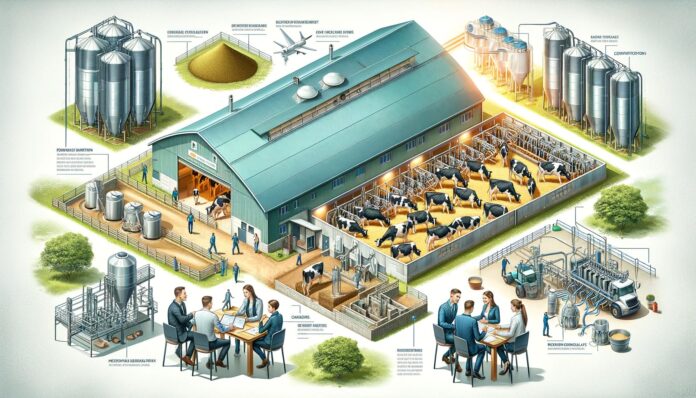Low Productivity of Indian Dairy Animals: Challenges and Mitigation Strategies
Dr. S. Praveen M.V.S., Ph.D., PGDAW.,
Veterinary Assistant Surgeon, Thiruvengadu, Mayiladuthurai, Tamil Nadu.
The livestock industry is an important part of the global food system, contributing to food security, poverty alleviation, and agricultural development. Livestock generates 40% of worldwide agricultural output and supports the livelihoods and food and nutrition security of about 1.3 billion people (McGuire, 2015). India has a cattle population of about 193.46 million, of which 142.11 billion are indigenous or non-descript, and India is the second-largest in the world in terms of cattle population (DADF, 2022). Total milk production in India was estimated to be about 221.06 MT (cattle and buffalo) and placed first in production among other countries. About 52% of milk production is from cattle, of which only 20.17% is from non-descript or indigenous cattle. The average milk production of indigenous, nondescript, crossbred, and exotic cattle is 4.07, 2.83, 8.32, and 11.36 kg/day, respectively. Though there are 53 registered indigenous cattle and 20 buffaloes, only 5 cattle, viz., Gir, Sahiwal, Redsindhi, Tharparkar, and Rathi, are considered high yielders with an average milk yield of 6-7 liters per day. but the milk yield is observed to be low compared to exotic cattle breeds like Jersey and Holstein Friesian.
 |
 |
 |
| Sahiwal (Milch Breed) | Umblachery (Draught breed) | Kankrej (Dual purpose) |
Figure 1. Indigenous breeds of cattle
Causes of low productivity in cattle
- An increase in the number of high-producing dairy cattle and buffaloes has been curbed.
- Lack of extension service, i.e., promotion of good cattle breeds
- Lack of credit facilities for small and marginal farmers
- Lack of a wide range of veterinary facilities
- Availability of limited grazing land due to a reduction in per capita farmland because of an increase in human population
- Backwardness of our agricultural practices and land improvement
- Lack of high-yielding breeds and improper feed
- Changes in climatic conditions
- Most cattle were used for draught and ploughing purposes rather than for milk production.
- Poor availability of good-quality feed and fodder
- Most cows with high genetic profiles were fed poor-quality feed or fodder.
- Prevalence of diseases and lack of prevention and treatment coverage at ground level.
- Lack of knowledge of rearing practices like milking, feeding, and disease management.
- Extreme weather in both the winter and summer seasons, climate, and geographical location of the animals.
- Improper drainage facilities and waste disposal provide a breeding ground for fly menaces and mosquito bites, which stress the animals.
Challenges
- Problems of infertility and repeat breeders.
- Problem with high genetic merit bulls.
- Low conception rate through artificial insemination.
- Inability of cattle rearers to bring animals to artificial insemination centers due to long distances.
- Lack of AI centers at village and hamlet levels.
- Low milk production costs more on rearing labor, which leads to reduced income per animal.
- Though improvement of animal productivity is largely done by crossbreeding and grading up programs, the milk production system is dominated by low-yielding animals.
- The lack of awareness regarding scientific farming and clean milk production causes economic loss to farmers.
- Though artificial insemination was used widely across the country, the coverage of the breedable population was only 40%, with a conception rate of 35–40%..
Mitigation strategies
- Various schemes have been developed to overcome the low productivity of Indian dairy cattle, like the National Dairy Plan, the National Programme for Bovine Breeding and Diary Development, the Rashtriya Gokul Mission, the National Livestock Mission, and the and the National Animal Disease Control Programme.
- Free insemination of animals by the National Artificial Insemination Programme has been implemented to increase AI coverage among breedable bovine populations.
- Animals of indigenous and dual-purpose cattle can be genetically improved by breeding with highly pedigreed and genetically proven bulls in their appropriate breeding track. For example, Gir and Kankrej are for Gujarat, and Ongole is for Andhra Pradesh. It is expected to improve milk production by 1–1.5% in dairy herds and 8–10% at the farmer level.
- Selective breeding and grading up of buffaloes for genetic improvement and to improve low-producing non-descript buffaloes in areas with moderately available feed and fodder resources. For example, Murrah, Surti, and Meshana buffaloes were used as superior bulls at existing organized farms.
- Cross breeding of low-yielding indigenous cows with exotic breeds of cattle like Jersey in plain areas and Holstein Friesian in hilly areas was used up to 62.5%–75% of exotic inheritance for the production of a large number of half-bred and higher crosses of animals at organized farms and field conditions.
- Biotechnological interventions like artificial insemination, embryo transfer technology, sexed semen technology for the production of female calves, cloning of animals, and invitro-fertilization technology were used at various research stations for the improvement of the productivity of animals.
- IVF buffalo calf (Pratham), cloned buffalo calf (Samrupa, Garima, Gamini, Shrestha, Mahima, Purnima, Lalima, Rajat), and calf from the somatic cell of semen (Swaran) were developed at the National Dairy Research Institute, Karnal.
- By replacing poor forage with highly digestible cereal silage.
- Periodic deworming of animals from calf to mother and educating the farmers regarding it.
- Employment of improved-skilled workers in cattle farming.
- Improvements in management practices like periodical deworming of calf at 15 days of age to adult cattle and regular vaccination for FMD, Brucellosis, and HS-BQ at 4 months of age.
- Fly control by dipping animals with ectoparasiticide.
Though various steps have been taken for genetic improvement and to increase the productivity of animals, the main area to be focused on is the implementation of door-step service to raise awareness among farmers through extension activities. This will improve the acceptability rate of schemes that were implemented for the betterment of the farming community and to meet the increasing demand for milk and meat among people.


